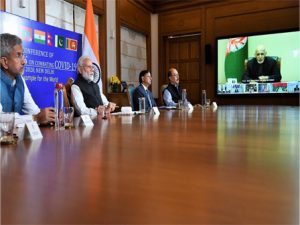COVID-19 Conundrum: Pandemic of Epic Proportions
From the wet markets, which are notorious for their uninhibited sale of wildlife animals ranging from antelopes and tigers to crocodiles and civet cats, the life-threatening Coronavirus has travelled almost all continents prompting millions of people to rush to protect their life. COVID-19 has killed thousands till now, prompting WHO to declare it as ‘Pandemic’.

In less than three months after being discovered in Wuhan, China, the novel Coronavirus or COVID-19 (short for, Coronavirus disease 2019) has claimed nearly 5100 deaths and affected more than 137,000 people in 112 nations. For this reason, World Health Organization (WHO) declared COVID-19 as a pandemic on 12 March. While the word pandemic might induce excessive fear or distress, there is still hope as nations everywhere are rushing to take proper measures.
The earliest reported cases of COVID-19 came from a ‘wet market’ in Wuhan. Wet markets are notorious for their uninhibited sale of wildlife animals – ranging from antelopes and tigers to crocodiles and civet cats. Viruses such as COVID-19, just as the 2003-SARS (Severe Acute Respiratory Syndrome), are zoonotic, which means that they originally germinate in animals and get transmitted to humans on contact. Such transmission can occur through sale, consumption, domestication or other forms of proximity. Even though, at present it might seem insignificant (given the more urgent need to contain the spread of the virus), it is nonetheless crucial to probe and address the roots of COVID-19 if we want to prevent the rise of such threatening diseases in the future.
The 2003 SARS outbreak, which claimed around 800 deaths globally, also came from these wet markets. Despite the blatant disregard and threat to human society and health, the Government of China permits the sale of a variety of animals in these markets, where bodily fluids like blood and saliva exchange between animals in extremely unhygienic environments that are breeding grounds for harmful viruses. Therefore, it was only a matter of time before another epidemic emerged. COVID-19 requires revisiting the history of some of the world’s deadliest viruses such as the AIDS and SARS, which came from monkeys and civet cats, respectively. Although we are yet to find conclusive evidence of coronavirus’s zoonotic origins, it bears concern that monkeys and civet cats are still found in plenty in Wuhan’s wet markets. Hence, even as we focus on the containment of COVID-19, we must also put our efforts behind preventing the abuse and slaughter of animals in uncontrolled conditions, which is unfortunately all too common in Indian cities too.
Also Read : Paediatricians Urge Who To Revise New Vaccine Guideline
Symptoms and Outbreak
The symptoms of COVID-19 are similar to common illnesses like pneumonia, which makes it difficult to detect the disease timely. The most common symptoms are fever, tiredness, and dry cough. Some patients may have aches and pains, nasal congestion, runny nose, sore throat or diarrhoea. These symptoms are usually mild and begin gradually. In more severe cases, the virus can cause pneumonia, SARS, kidney failure and even death. It has been found to affect aged-people and those with low-immunity more fatally.
Since being detected in Wuhan on December 31, 2019, the virus has spread quite rapidly across the world. The first death from COVID-19 was reported on 11 January 2020 in Wuhan, whereas the first case outside of China was reported in Thailand on 13 January in a person who was travelling from Wuhan. In the same week, Japan also reported its first case. In the following two weeks, more than 5000 people were affected and 106 dead in China alone. Soon after, the United States, Nepal, France, Australia, Malaysia, Singapore, South Korea and Taiwan confirmed their first cases of COVID-19.
On 30 January, WHO declared the COVID-19 as a ‘Public Health Emergency of International Concern’ – also referred to as an ‘epidemic’– as the virus spread across China, affecting nearly 8000 people and taking 170 lives.
The past month has been especially troubling. Coronavirus related cases and fatalities have been reported in large numbers in Iran, Italy, and several other European and Middle-Eastern countries. By 13 March, the coronavirus has killed nearly 5069 people and infected a total of 137,066 people across more than 100 countries as confirmed by CSSE at John Hopkins University.
India, too, is at high-risk, due to several factors which include its population, lack of extensive medical preparedness, local market conditions, mass gatherings for religious worship, and public transport facilities.
Coronavirus in India

India had suffered its first casualty to the coronavirus on 13 March. Almost 100 cases in total have been reported so far with the maximum incidence in Kerala with 17 cases, and high numbers in Rajasthan, Karnataka, Uttar Pradesh, Maharashtra, Delhi and Telangana.
In Kerala, around 1200 people have been quarantined (149 in isolation in hospitals, others at home). The state government has shut down schools, cinema halls, and colleges till 31 March. The Telangana government has allocated 100 crore rupees for the prevention of coronavirus break in the state. Three new hospitals have been set up and dedicated to COVID-19 cases. Other state governments are taking proactive measures too.
The Union government also sent flights and aircrafts to bring back Indian nationals stuck in China, Iran and a few who were on board the Diamond Princess cruise ship, docked off in Yokohama, Japan. It has also issued an advisory regarding the pandemic, stating that all non-essential travel by Indian nationals must be avoided. The government has even suspended tourism to India and the issuance of travel visas to India till 15 April. Further, the government intends to quarantine returning Indian nationals for a period of 14 days as it is a sufficient time for symptoms to appear. These are rather strong measures, which have not been taken by other countries so far, but wholly justifiable in light of the current situation.
Vaccine Development
Heavy research is underway to find a cure for COVID-19. Certain drugs that have worked against HIV and Ebola virus are now being tested against coronavirus. However, the prospects of using Remdesivir drug (which is used against Ebola virus) seem bleak as results have not been convincing. But, on a positive note, the antiretroviral drugs (used to treat HIV) are also being tested and have already been medically approved for humans. So if it shows efficiency in combating the coronavirus, we will save sufficient time by avoiding mandated lab testing and other medical formalities.
Battle against the New Epidemic
WHO has issued an advisory about basic measures we can take against coronavirus. It has called for “urgent and aggressive action” by every country. It has advised industries and governments to increase the manufacturing of face masks and protective suits by 40% to meet the rising global demand as there has been “widespread inappropriate use”.
Also Read : Krokodil A Deadly Drug Designed From Russia
The Director-General of WHO, Tedros Adhanom Ghebreyesus, also appointed six special envoys for COVID-19, to provide strategic advice and political advocacy in different parts of the world against this disease.
The United Nations Humanitarian Chief Mark Lowcock released US$15 million from its Central Emergency Response Fund to the WHO and UNICEF to help fund global efforts against COVID-19.
The spread of COVID-19 has instilled a sense of urgency and fear among people and governments everywhere. Global financial markets are suffering a meltdown. Many celebrities like Tom Hanks and world leaders like Justin Trudeau have been affected along with their families. This is a difficult period for the global community, but if history and our response to crisis is any consolation, then we might be on the right track. No doubt, more precaution and action will go a long way as the virus is fatal in severe cases and every life lost is one loss too many. One can only hope that we take important lessons from this outbreak and begin to plan ahead as the world population, globalisation and food consumption is only rising and will bring along new threats and opportunities for our societies.
